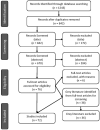The Role of Whole Genome Sequencing in the Surveillance of Antimicrobial Resistant Enterococcus spp.: A Scoping Review
- PMID: 34178909
- PMCID: PMC8222819
- DOI: 10.3389/fpubh.2021.599285
The Role of Whole Genome Sequencing in the Surveillance of Antimicrobial Resistant Enterococcus spp.: A Scoping Review
Abstract
Enterococcus spp. have arisen as important nosocomial pathogens and are ubiquitous in the gastrointestinal tracts of animals and the environment. They carry many intrinsic and acquired antimicrobial resistance genes. Because of this, surveillance of Enterococcus spp. has become important with whole genome sequencing emerging as the preferred method for the characterization of enterococci. A scoping review was designed to determine how the use of whole genome sequencing in the surveillance of Enterococcus spp. adds to our knowledge of antimicrobial resistance in Enterococcus spp. Scoping review design was guided by the PRISMA extension and checklist and JBI Reviewer's Guide for scoping reviews. A total of 72 articles were included in the review. Of the 72 articles included, 48.6% did not state an association with a surveillance program and 87.5% of articles identified Enterococcus faecium. The majority of articles included isolates from human clinical or screening samples. Significant findings from the articles included novel sequence types, the increasing prevalence of vancomycin-resistant enterococci in hospitals, and the importance of surveillance or screening for enterococci. The ability of enterococci to adapt and persist within a wide range of environments was also a key finding. These studies emphasize the importance of ongoing surveillance of enterococci from a One Health perspective. More studies are needed to compare the whole genome sequences of human enterococcal isolates to those from food animals, food products, the environment, and companion animals.
Keywords: Enterococcus; One Health; antimicrobial resistance; nosocomial infection; scoping review; surveillance; whole genome sequencing.
Copyright © 2021 Rogers, Strong, Cork, McAllister, Liljebjelke, Zaheer and Checkley.
Conflict of interest statement
The authors declare that the research was conducted in the absence of any commercial or financial relationships that could be construed as a potential conflict of interest.
Figures





Similar articles
-
First Report of the Local Spread of Vancomycin-Resistant Enterococci Ascribed to the Interspecies Transmission of a vanA Gene Cluster-Carrying Linear Plasmid.mSphere. 2020 Apr 8;5(2):e00102-20. doi: 10.1128/mSphere.00102-20. mSphere. 2020. PMID: 32269153 Free PMC article.
-
Rapid Transmission and Divergence of Vancomycin-Resistant Enterococcus faecium Sequence Type 80, China.Emerg Infect Dis. 2025 May;31(5):1000-1005. doi: 10.3201/eid3105.241649. Emerg Infect Dis. 2025. PMID: 40305388 Free PMC article.
-
Genome analysis of multidrug resistant Enterococcus faecium and Enterococcus faecalis circulating among hospitalized patients in uMgungundlovu District, KwaZulu-Natal, South Africa.BMC Infect Dis. 2024 Jul 4;24(1):671. doi: 10.1186/s12879-024-09380-3. BMC Infect Dis. 2024. PMID: 38965470 Free PMC article.
-
Genomics of vancomycin-resistant Enterococcus faecium.Microb Genom. 2019 Jul;5(7):e000283. doi: 10.1099/mgen.0.000283. Epub 2019 Jul 22. Microb Genom. 2019. PMID: 31329096 Free PMC article. Review.
-
Vancomycin resistant Enterococci: A brief review.J Pak Med Assoc. 2018 May;68(5):768-772. J Pak Med Assoc. 2018. PMID: 29885179 Review.
Cited by
-
Nosocomial outbreak of vancomycin-resistant Enterococcus faecium (VRE) ST796, Switzerland, 2017 to 2020.Euro Surveill. 2022 Dec;27(48):2200285. doi: 10.2807/1560-7917.ES.2022.27.48.2200285. Euro Surveill. 2022. PMID: 36695463 Free PMC article.
-
Promiscuous, persistent and problematic: insights into current enterococcal genomics to guide therapeutic strategy.BMC Microbiol. 2024 Mar 28;24(1):103. doi: 10.1186/s12866-024-03243-2. BMC Microbiol. 2024. PMID: 38539119 Free PMC article. Review.
-
Factors associated with antimicrobial resistant enterococci in Canadian beef cattle: A scoping review.Front Vet Sci. 2023 Apr 20;10:1155772. doi: 10.3389/fvets.2023.1155772. eCollection 2023. Front Vet Sci. 2023. PMID: 37152689 Free PMC article.
-
Enterococcus faecium as an Emerging Pathogen: Molecular Epidemiology and Antimicrobial Resistance in Clinical Strains.Pathogens. 2025 May 15;14(5):483. doi: 10.3390/pathogens14050483. Pathogens. 2025. PMID: 40430803 Free PMC article.
-
Comparative Analysis of Short- and Long-Read Sequencing of Vancomycin-Resistant Enterococci for Application to Molecular Epidemiology.Front Cell Infect Microbiol. 2022 Apr 6;12:857801. doi: 10.3389/fcimb.2022.857801. eCollection 2022. Front Cell Infect Microbiol. 2022. PMID: 35463637 Free PMC article.
References
Publication types
MeSH terms
LinkOut - more resources
Full Text Sources
Miscellaneous

